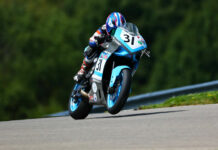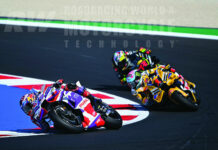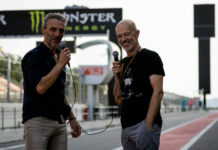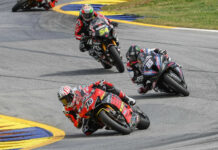By John Ulrich I formulated the Big Mac Theory of race officiating about 15 years ago after discovering that one of my racebikes could pass tech at six races in a row and then fail at a seventh race, simply because it was examined by a different tech official. One of the appeals of McDonald’s is predictability. Go to any McDonald’s and order a Big Mac, and you get a Big Mac, whether you’re in Newburgh, New York or Tokyo, Japan, and whether you’re Bill Clinton (he was President when the Big Mac Theory was formulated) or a homeless bag lady. That’s by design. McDonald’s has an operations manual and a training program that lays out exactly how everything has to be done at every McDonald’s. The goal is consistency, with every customer at every McDonald’s getting the same Big Mac and the same service, no matter where they are and no matter who they are. Racing organizations should be like that. No matter who they are, no matter what racetrack they’re at, every participant should be treated the same, every time. Just like McDonald’s has its operations manual, racing organizations have a rulebook that lays out exactly how everything is supposed to be done at every event. Which brings me to the current sad state of officiating at AMA Pro Racing events. I know there’s a rulebook. But by the way the 2009 AMA Pro season has been going, I wonder if anybody in any position of authority has seen, read or even heard of the rulebook. In theory, any time anybody at AMA Pro Racing wants to do something, the first stop should be the rulebook. The first question should be, does whatever we want to do, comply with the rulebook? If not, then the obvious course of action is to either change the rule in question””with plenty of notice and a complete explanation of why it’s necessary made to anybody who might be affected””or, change the planned course of action. In practice, AMA Pro Racing officials this season have consistently ignored the rulebook or come up with warped interpretations of rulebook wording that no reasonable person would believe or accept. It started at Daytona when Al Ludington told Honda CBR600RR teams that they could relocate the rear brake caliper from above the swingarm to below the swingarm, a change that makes it easier to quickly change the rear wheel during a Daytona 200 pit stop. When I asked why, the answer I got from Ludington was, “Because the rulebook doesn’t say they can’t.” Which ignores the fact that the rulebook clearly states that unless a change or modification is called out as being allowed, it isn’t legal. That fact was emphasized by AMA Pro Racing’s Colin Fraser in rider and entrant meetings at Daytona: If the rulebike doesn’t specifically say you CAN do something, that means you CAN’T do it. When I pointed this out, Ludington’s reaction was to say, “I’m sure I can find some funny things on your team’s bikes, too.” He followed that statement up by charging over to my race team’s pit area and harassing my crew. If the man in charge of Tech doesn’t know what the rulebook says and what riders and entrants are being told by the guy in charge of race officiating, ignores both when deciding what is or is not legal, and gets mad when the actual rule is pointed out, what hope is there for an orderly, fair racing series? As it turns out, none. At Road America, several riders were tagged with “jumped starts” for moving inside their grid box after the starting lights came on but before the lights went out to signal the actual start of the race. The involved riders were given ride-through penalties, ruining their races. One rider who I watched move inside his box, and who was not penalized, was Mat Mladin. Watch the TV shows covering the American Superbike races at Road America and look carefully””you can clearly see Mladin move before anybody else on the grid. Seeing that on TV does not mean that Mladin jumped the start, and it does not mean that Mladin did not jump the start. In fact, there really is no way for a TV viewer to know exactly when the starting lights come on, because there isn’t a time-synched display of the lights on the TV screen. Asked about the penalties a week after the race, Roger Edmondson told me that the same applied for all the riders who were penalized, because, as Edmondson told it, the guy watching the grid-row-camera monitors up in timing & scoring didn’t have a time-synched display showing when the lights came on and went off, either. In other words, what Edmondson told me was that the penalties handed out at Road America were based on a guess made by an AMA Pro Racing staffer looking at monitors in a room located in the timing & scoring and suite building, well above the grid. In this case, Mat Mladin got lucky because he was not charged with jumping the start (whether he was innocent or not), while guys like Geoff May and Neil Hodgson and Josh Hayes and Taylor Knapp and Chris Ulrich were charged with jumping the start, (whether they were guilty or not). Disclaimer for the reading impaired: I am not saying that Mat Mladin jumped a start. What I am saying is, Mladin is lucky that some AMA Pro Racing official didn’t claim he (Mladin) jumped the start despite a lack of any valid evidence. In several of those cases, the momentary movement was the result of the rider dropping his bike into gear, and in all those cases the rider was again stationary before the lights went out to signal the start of the race. In all those cases, there was no unfair competitive advantage gained by anybody, Mladin included. Asked about the penalties Sunday afternoon at Road America, AMA Pro Racing’s Bill Syfan said that the goal was to remove judgment calls from the equation, to make the rule and its enforcement black-and-white. When the previous AMA Pro Racing regime experimented with that concept a few years ago, riders who ran off the track at Fontana and LOST positions and time were then called in for a ride-through penalty. It makes no sense. If removing judgment calls is the goal, how do officials decide if a rider has done something wrong during a rolling start as used in Daytona SportBike? There are no boxes to keep the front wheel in, and no grid cameras. If removing judgment calls is the goal, why do we have officials in the first place? And if the officials we do have can’t make a reasonable judgment call, why do they have jobs as racing officials? The bottom line is that the rulebook exists to ensure fair competition. Rules dealing with grid starts and running off the track are supposed to keep riders from unfairly gaining an advantage over the competition, as in rolling before the lights go out or cutting the track to pass somebody or gain time. Officials who don’t understand that primary purpose of a rulebook and the rules it contains, should not be officials. Today along pit lane at Mid-Ohio, Bill Syfan told me that he personally made the call on the jump starts at Road America, and that he based his decisions on looking at replays from the grid cameras and comparing them to a shot of the starting lights taken by another camera. He was able to wind the recordings back and forth and to determine exactly when the lights came on, exactly when they went off to start the race, and when the riders in question moved inside their grid box, Syfan said. He said again that the goal of penalizing ANY movement inside the box was to eliminate any questions of fairness and to eliminate judgment calls or vagueness. I keep coming back to the intent and purpose of rules regarding grid movement or running off the track: To prevent any unfair competitive advantage being gained. If there was no unfair advantage gained, any enforcement of a rule designed to prevent that, is bad officiating. In other words, a judgment call HAS to be made. In a related incident today at Mid-Ohio, Al Ludington reacted to Version 1 of this editorial by asking Roadracing World reporter David Swarts–who was standing next to Yamaha’s Tom Halverson–where I was and then adding that it was “time for some vindictive teardowns” of my race team’s bikes. Ludington followed that up by confronting Martin Cardenas’ lead mechanic, Robin Hawley, on pit lane, again saying it was “time for some vindictive teardowns” of my race team’s bikes. Ludington then said the same thing to my team’s crew chief, Keith Perry, although as Perry explained it to me, “after he had vented to Robin, he was laughing by the time he said it to me.” Ludington wasn’t laughing when he spoke to Swarts, and he wasn’t laughing when he spoke to Hawley. I have no doubt he was dead serious, although he later found me on pit lane and told me that he was kidding–after I had asked AMA Pro Racing upper management what was going on with the apparent threat made to Swarts, but before I learned that Ludington had also made the comment to Hawley. Bad joke, Al, bad joke. Not funny at all. (Ludington didn’t apologize, he just stated that he was kidding and that he would never actually conduct punitive teardowns. AMA Pro Racing’s Roy Janson and Ollie Dean both apologized for Ludington’s comments after the fact, but Ludington did not and has not, and I saw no hint of remorse on his face when he spoke to me, just residual anger. From what I’ve seen of the man this season alone, my opinion is that he WOULD conduct “vindictive teardowns” if he thought he could get away with it, although I am not sure what it would accomplish–Cardenas’ bike was found to be legal when it was torn down to the transmission later that same day.) That’s pretty bad stuff to hear from a racing official in America, but it wasn’t that bizarre threat (or joke, your choice) that led to this editorial being written in the first place. My primary motivation for writing this piece was the latest rulebook-related debacle-“”call it the last straw in a string of bizarre decisions that pay no heed to the letter and intent of the rulebook. A couple of months ago Erik Buell told me that he wanted to homologate a bunch of racing parts for the 1125R and start racing it seriously in the AMA American Superbike class. The problem, he told me, was that AMA Pro officials told him that they would only approve the parts if Buell put them on a bike and sold it as a complete, ready to go motorcycle, in essence a racing-only model or version of the 1125R. I didn’t think much about it, and didn’t consult the rulebook at the time. But as it turns out now, there is no reasonable interpretation of the rulebook that allows for homologation of a racing-only model or version of a motorcycle for production-based AMA Pro competition. Which means that AMA Pro officials either didn’t read their own rulebook before deciding to homologate the Buell 1125RR, or chose to ignore it. The Buell in question made its debut at Mid-Ohio this weekend, the paddock in an uproar and Erik Buell being vilified for doing something AMA officials told him to do, which is opposite of what he wanted to do in the first place. When racing officials either don’t read their own rulebook or choose to ignore it, there is no hope for a fair, orderly racing series. When racing officials react in fury to any questioning of their decisions based on what the rulebook actually says, there is no hope for a fair, orderly racing series. Racing series live or die by their rulebook, by reasonable interpretation of the rulebook, and by fair and equal enforcement of the rules therein. In AMA Pro Racing circa 2009, we’re not getting any Big Macs.
© , Roadracing World Publishing, Inc.






